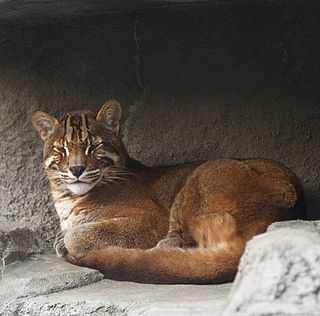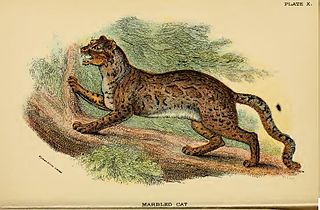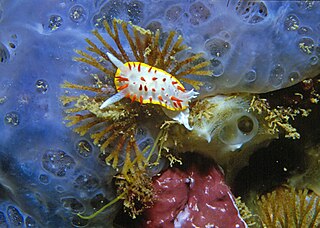
Catopuma is a genus of felid containing two small wild cat species, the Asian golden cat and the bay cat. Together with the genus Pardofelis it forms the bay cat lineage of felines. Both are typically reddish brown in colour, with darker markings on the head.

George Busk FRS FRAI was a British naval surgeon, zoologist and palaeontologist.

Pardofelis is a genus of the cat family Felidae. This genus is defined as including one species native to Southeast Asia: the marbled cat. Two other species, formerly classified to this genus, now belong to the genus Catopuma.

Hans Busk the younger DL was one of the originators of the "Volunteers".

Valdoraptor is a genus of theropod dinosaur from the Early Cretaceous. Its fossils were found in England. It is known only from bones of the feet. The holotype, BMNH R2559, was found near Cuckfield in layers of the Tunbridge Wells Sand Formation dating from the late Valanginian. The specimen is damaged lacking parts of the upper and lower ends. It has a conserved length of 215 millimetres (8.5 in) and an estimated length of 240 millimetres (9.4 in). This genus is paleontologically significant for being the first ornithomimosaur specimen known from England and represents the earliest record of ornithomimosaurs.

Bugula is a genus of common colonial arborescent bryozoa, often mistaken for seaweed. It commonly grows upright in bushy colonies of up to 15 cm in height.

Pinna is a genus of bivalve molluscs belonging to the family Pinnidae. The type species of the genus is Pinna rudis.

Atrina is a cosmopolitan genus of bivalve molluscs belonging to the family Pinnidae.

Nyctophilus is a genus of the vespertilionids or vesper bats. They are often termed Australian big-eared bats or long-eared bats, as the length of their ears often greatly exceeds that of the head. This genus occurs in the New Guinean-Australian region.

Triphyllozoon is a genus of bryozoans in the family Phidoloporidae.

Cornularia is a genus of soft corals in the suborder Stolonifera.

Catenicella are a genus of bryozoans in the family Catenicellidae.

Sertularia is a genus of hydroids in the family Sertulariidae.
Zygophylacidae is a family of hydrozoans.

Windmill Hill Cavern is a limestone cave system in the town of Brixham, Devon. It was discovered in 1858 and later excavated by a team led by the geologist William Pengelly, who found proof that humans co-existed with extinct British fauna.
Licornia is a genus of gymnolaematan bryozoans.
Pseudidmonea is a genus of bryozoans belonging to the monotypic family Pseudidmoneidae.
Columnella is a genus of bryozoans belonging to the family Farciminariidae.
Gephyrophora is a genus of bryozoans belonging to the family Gigantoporidae.
Bugulina is a genus of bryozoans in the family Bugulidae.














